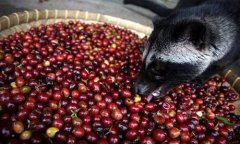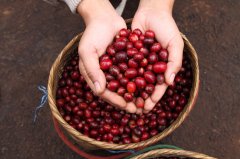What are the practices of different varieties of coffee
Gappuccino/Cappuccino Coffee in the early 20th century, Italian Azibucha invented the steam pressure coffee machine, but also developed the cappuccino coffee. Cappuccino is an Italian coffee mixed with the same amount of Italian espresso and steamed milk. At this time, the color of coffee is like a cappuccino monk covering a dark brown coat with a headscarf, hence the name caffeine. The traditional cappuccino is 1/3 espresso, 1/3 steamed milk and 1/3 foamed milk. The full-bodied taste of espresso, accompanied by lubricated foam; it has a hint of essence and dew. Sprinkled with foamed milk with cinnamon powder, mixed with the aroma of bottom-up Italian coffee, the new generation of coffee is fascinated by it. It has an irresistible unique charm, at first it smells good, when you drink it, you can feel the sweetness and softness of a large number of milk bubbles, and the second taste can really taste the original bitterness and richness of coffee beans. finally, when the taste stays in the mouth, you will feel more mellow and meaningful. Don't you think it's amazing that a kind of coffee can have many different unique flavors? The first mouthful always makes people feel bitter and sour, a large number of bubbles are like young people's light life, and the bursting of bubbles and that little bitterness are like a conflict between dreams and reality. Finally, after tasting the joys and sorrows of life, the sweetness of life is intoxicating. This is like a teenager in adolescence. After enjoying a childish and wonderful time, they have to face the impact of stepping into the adult world and really taste the original taste of life-in addition to sweetness and bitterness.
The origin of cappuccino Fanz George Kolschitsky of Vienna is the founder of Cafe Latte with milk and coffee. Both drinks are made from coffee and milk, but cappuccino has a more knowledgeable origin and has always been the best material for the study of character changes in Europe and the United States. The history of the word Cappuccino: the monks of the St. Franciscan Church (Capuchin), founded five years later in 1525, all wore brown robes and pointed hats. When the St. Franciscan Church spread to Italy, the locals thought the monks' clothes were very special, so they gave them the name Cappuccino. The Italian word refers to the loose robes and small pointed hats worn by monks, derived from the Italian word "headscarf" or Cappuccio. However, Old Yi loved coffee and found that when espresso, milk and milk foam were mixed, the color was like the dark brown robe worn by monks, so he came up with a drink with coffee and sharp milk bubbles, which was named Cappuccino. The word was first used in English in 1948, when a report in San Francisco first introduced cappuccino beverages, and it was not until 1990 that it became a familiar coffee drink. It should be possible to say that the word Cappuccino coffee comes from the St. Franciscan Church (Capuchin) and the Italian headscarf (Cappucio). It is believed that the original word makers of Cappuccino never dreamed that the monks' robes would eventually become the name of a coffee drink. Cappuccino is also related to the name of a monkey. There is a small monkey in Africa with a black cone-shaped hair on its head, much like a pointed hat on a St. Franciscan robe, hence the name Capuchin, which was first used by the British in 1785. The word Capuchin has generated coffee drink names and monkey names hundreds of years later, which has always been an interesting story for literati. Dry cappuccino and wet cappuccino do you know that cappuccino can be dry or wet? The so-called dry cappuccino (Dry Cappuccino) refers to the conditioning method with more milk bubbles and less milk. it tastes stronger than milk and is suitable for people with heavy taste. When it comes to wet cappuccino (Wet Cappuccino), it refers to the practice of fewer milk bubbles and more milk, with milk fragrance overshadowing the thick coffee flavor, which is suitable for those with light taste. The flavor of the wet cappuccino is similar to that of the popular latte. Generally speaking, the taste of cappuccino is heavier than latte. If you have a heavy taste, you might as well order cappuccino or dry cappuccino. If you are not used to the heavy smell of coffee, you can order latte or wet cappuccino. Cappuccino coffee is made on the basis of Italian espresso and a thick layer of foaming milk is made into cappuccino. The quality of espresso can be seen in milk and foam, but it is still an important factor in determining the taste of cappuccino. Pour the partially skimmed milk into a pot, then use a foamer to foam and inflate the milk, and let the milk be as uniform as whipped cream without burning. The cappuccino coffee cup should be warm or the milk foam will spread. You can usually put these cups on the top of the coffee maker to keep warm. Pour the milk and foam on top of the espresso and form a natural layer, just like wrapping the coffee below. Note that the brewed Italian coffee is about five cents full, and the hot milk that has been foamed is about eight cents full. Finally, you can sprinkle a little cinnamon powder or chocolate powder and pour the rest of the milk together to make a delicious cappuccino.

Important Notice :
前街咖啡 FrontStreet Coffee has moved to new addredd:
FrontStreet Coffee Address: 315,Donghua East Road,GuangZhou
Tel:020 38364473
- Prev

Civet Coffee (Kopi Luwak) is the most expensive coffee among many.
Civet Coffee (Kopi Luwak) Coffee Coffee is a recently invented coffee made from cat poop. It is the most expensive coffee among many. Blue Mountain Coffee Blue Mountain Coffee is a popular coffee produced in Central America, Jamaica and the West Indies. It is mellow, slightly sweet in bitterness and smooth in taste.
- Next

The most representative is that "Cubita Coffee" is all produced in Cuba's Crystal Mountain boutique coffee.
Cuban Crystal Mountain Coffee (cubita coffee) in Cuba, the cultivation of coffee is regulated by the state. The best coffee growing area in Cuba is located in the Central Mountains. Because this area not only grows coffee, but also produces quartz, crystal and other precious minerals, it is also known as Crystal Mountain. At present, Crystal Mountain Coffee is synonymous with top Cuban coffee. The most representative is
Related
- Does Rose Summer choose Blue, Green or Red? Detailed explanation of Rose Summer Coffee plots and Classification in Panamanian Jade Manor
- What is the difference between the origin, producing area, processing plant, cooperative and manor of coffee beans?
- How fine does the espresso powder fit? how to grind the espresso?
- Sca coffee roasting degree color card coffee roasting degree 8 roasting color values what do you mean?
- The practice of lattes: how to make lattes at home
- Introduction to Indonesian Fine Coffee beans-- Java Coffee producing area of Indonesian Arabica Coffee
- How much will the flavor of light and medium roasted rose summer be expressed? What baking level is rose summer suitable for?
- Introduction to the characteristics of washing, sun-drying or wet-planing coffee commonly used in Mantenin, Indonesia
- Price characteristics of Arabica Coffee Bean Starbucks introduction to Manning Coffee Bean Taste producing area Variety Manor
- What is the authentic Yega flavor? What are the flavor characteristics of the really excellent Yejasuffi coffee beans?

